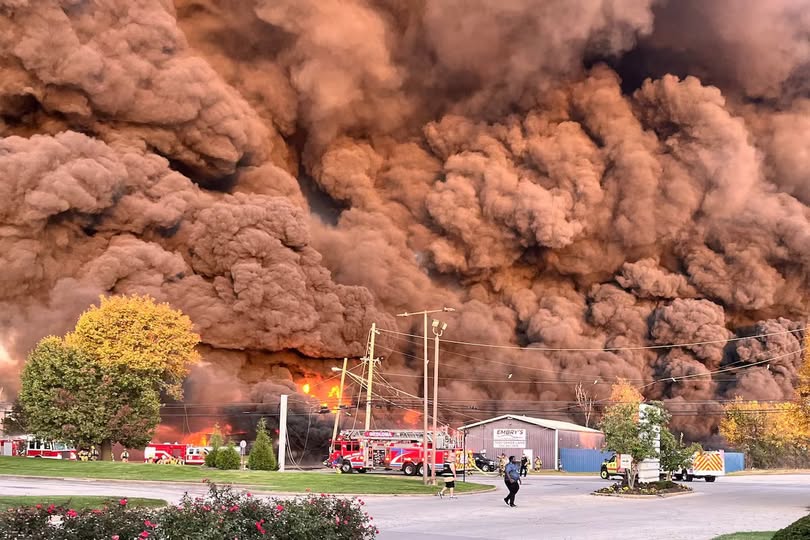In the calm darkness before sunrise on Tuesday, November 4, 2025, Louisville, Kentucky — a city built on movement, trade, and heart — awoke to a tragedy that will echo for decades. The routine hum of engines at Muhammad Ali International Airport was shattered when UPS Flight 2976, a cargo freighter bound for Dallas–Fort Worth, went down shortly after takeoff. What should have been an ordinary morning became a defining moment of heartbreak, courage, and unity for an entire community.
The tragedy not only claimed lives but also shook the city’s identity. Louisville, home to UPS Worldport, the largest automated package handling facility on Earth, suddenly found itself confronting the fragility of progress — and the resilience of its people.
1. The Final Takeoff: From Routine to Disaster
For years, UPS Flight 2976 had been part of Louisville’s nightly rhythm — another symbol of a city that never slept. The freighter, a McDonnell Douglas MD-11F, had served the company reliably for over two decades. On this fateful morning, its cargo included time-sensitive shipments — medical equipment, electronics, and seasonal packages headed toward Texas.
At precisely 6:02 a.m., the aircraft began its takeoff roll from Runway 17R under the command of a seasoned crew of three. Conditions were calm. The sky was still painted in hues of early dawn. Airport workers later said the takeoff appeared “perfectly normal” — until it wasn’t.
Moments after lift-off, controllers noticed an unusual flicker on their radar screens, followed by a mayday call. Witnesses described a deep, rumbling sound before the aircraft veered slightly left. Seconds later, a blinding orange glow illuminated the horizon. The sound that followed — a concussive blast that shook buildings within miles — signaled that Louisville had just lost one of its own.
2. Flames Over Louisville: The First Responders’ Race Against Time
The plane went down less than a mile from the runway, striking an industrial district near Preston Highway. Within seconds, warehouses, parked trucks, and nearby houses were engulfed in fire. The Louisville Fire Department, Metro Police, and emergency medical teams mobilized instantly.
Firefighters described what they saw as “a corridor of flame.” Fuel from the freighter’s massive tanks fed an inferno that made the air itself shimmer with heat. The flames were so intense that thermal cameras registered readings above 1,200 degrees Fahrenheit.
Despite the danger, responders advanced through debris, explosions, and collapsing structures. For over ten hours, they battled the blaze, often without clear visibility. Neighbors watched helplessly as clouds of black smoke billowed into the sky.
Mayor Craig Greenberg declared a state of emergency within the first hour, urging calm and cooperation. “Louisville has faced storms, floods, and hardship,” he said during a live briefing, his voice trembling. “But this… this touches our soul. We will stand together.”
Residents within a mile were asked to stay indoors due to potential air contamination. Schools delayed openings. Local businesses halted operations to allow access to rescue teams. For the first time in years, Louisville — a hub of constant motion — stood still.
3. The Human Toll: Faces Behind the Tragedy
By midday, the reality set in. Twelve people were confirmed dead — three UPS crew members and nine residents from the affected area. Among the victims was a child, whose loss would become a heartbreaking symbol of the tragedy’s reach.
Dozens more were injured, many suffering burns or smoke inhalation. Hospitals reported an overwhelming influx of patients, prompting nearby cities to send additional medical teams.
The names of the crew — all veteran aviators — were later released with permission from their families. Colleagues described them as “professionals to the end,” having attempted to steer the failing aircraft away from homes and populated areas. Their decision likely saved many lives on the ground.
At the crash site, makeshift memorials began appearing almost immediately: candles, handwritten notes, and flowers laid gently along chain-link fences. Children placed toy airplanes near the site, a quiet tribute to those who had taken flight and never returned.
4. A City Unites: Strength Amid the Rubble
Even as smoke lingered in the air, Louisville’s spirit rose higher than the flames. Strangers became neighbors, and neighbors became heroes. Churches opened their halls to displaced families. Restaurants offered free meals to responders and victims’ relatives. Volunteers organized clothing drives and temporary shelters.
UPS itself — deeply intertwined with the city’s identity — took swift action. Operations at Worldport were paused for nearly twelve hours, a rare move in a company that processes over 2 million packages per day. Executives and employees joined volunteers at local relief centers, providing resources and emotional support.
In an official statement, the company pledged long-term assistance to the affected families. “Our city is hurting,” the statement read, “but Louisville’s strength lies in its people. Together, we will rebuild what was lost.”
Psychological counselors were brought in to help workers and residents process trauma. Many reported persistent anxiety and flashbacks. “It’s not just the sound of the crash,” said one UPS employee. “It’s the silence that followed.”
5. The NTSB Steps In: Searching for the Truth
The National Transportation Safety Board (NTSB) immediately launched a full investigation. Within hours, specialists arrived on site to collect black box data, flight recorders, and debris samples. The agency confirmed that the left engine of the aircraft appeared to have suffered a catastrophic structural failure, triggering a fire that rapidly spread to the fuel lines.
Preliminary findings suggested metal fatigue — a rare but devastating mechanical flaw that can occur despite regular maintenance. The NTSB’s lead investigator emphasized that determining the root cause could take months, possibly longer.
Investigators also examined maintenance logs, crew training records, and operational procedures. They interviewed air traffic controllers, witnesses, and first responders. Nothing was left to assumption.
FAA representatives joined the inquiry, focusing on regulatory oversight. While no immediate evidence of negligence was found, the investigation underscored the complexity of aging cargo fleets and the need for continued investment in modernization.
6. Lessons in Loss: Safety, Technology, and Responsibility
Aviation experts across the nation weighed in. Some argued that the tragedy reflected broader challenges in the cargo sector — aging aircraft, overworked crews, and limited access to replacement parts. Others pointed to the industry’s strong safety record, emphasizing that every incident, no matter how rare, offers vital lessons.
As public discourse grew, lawmakers called for hearings on aviation safety and infrastructure funding. Kentucky’s congressional delegation urged collaboration between the FAA and private carriers to prevent future disasters.
UPS responded proactively, initiating its own internal audit. Engineers reviewed fleet maintenance schedules and accelerated plans to retire older aircraft. The company also introduced new AI-based monitoring systems to detect early signs of mechanical stress — a move praised by analysts as “the future of predictive safety.”
7. Healing the Heart of Louisville
Weeks turned into months, and Louisville began to heal — slowly, but visibly. The crash site was cleared and transformed into a memorial garden, where families could gather in remembrance. The city organized candlelight vigils, with thousands attending to honor the victims.
Community leaders emphasized unity over blame. “This tragedy reminded us that behind every package, every flight, and every job is a person,” said Mayor Greenberg during a remembrance ceremony. “We must never forget the humanity that connects us all.
Artists and schoolchildren collaborated on murals depicting wings rising from the ashes — a symbol of hope that soon adorned the side of a local fire station. For many residents, those wings became a metaphor: that even in the darkest times, Louisville would continue to rise.
8. Economic and Emotional Aftershocks
The impact extended beyond grief. UPS temporarily reduced overnight operations, affecting thousands of workers and partner businesses. Economic experts estimated a short-term regional loss exceeding $40 million, primarily from shipping disruptions and property damage.
Yet, amid the financial toll, solidarity flourished. Local banks offered relief loans, nonprofits organized fundraising concerts, and tech companies donated software and equipment to aid recovery. Even international partners expressed condolences, with aviation unions around the world observing a moment of silence.
Inside UPS, morale wavered but did not collapse. Employees wore black armbands and carried small patches bearing the number “2976.” One longtime mechanic said, “It’s not just a number — it’s family.”
9. Voices of Resilience
In interviews, survivors and first responders reflected on the emotional weight of that morning. A firefighter recounted pulling an injured man from debris, saying, “He kept asking about the pilots. Even through pain, he cared about the people in the sky.”
A teacher from a nearby school described how her students wrote letters to the families of victims, each one ending with the same line: ‘Louisville loves you.’
Grief counselors described the collective trauma as both devastating and transformative. “Tragedy strips away illusion,” one said. “What remains is connection — and the will to carry on.”
10. Looking Forward: Building a Safer Sky
In the year following the crash, new policies emerged. UPS accelerated its shift toward newer, more efficient freighters with advanced flight control systems. Federal agencies enhanced inspection frequency for aging cargo aircraft. Louisville Airport introduced new fire suppression infrastructure and upgraded its emergency command center.
These measures — though technical — carried deep symbolic value. They represented a promise: that the lessons of Flight 2976 would not fade into history, but live on as a commitment to safety, compassion, and accountability.
At the dedication of the Flight 2976 Memorial Park, a survivor’s mother spoke words that silenced the crowd:
“Tragedy may define a day, but how we choose to remember defines who we are. Our city will not be remembered by how it fell — but by how it stood back up.”
11. The Legacy of Flight 2976
Today, more than a year later, the story of Flight 2976 continues to resonate. It is retold not just in aviation manuals or government reports, but in classrooms, churches, and homes across Kentucky. It serves as a reminder that progress and compassion must walk hand in hand.
For the people of Louisville, this wasn’t just about a crash — it was about rediscovering what community means in the face of loss. It’s about firefighters who ran toward flames, neighbors who opened doors, and strangers who became family overnight.
UPS Flight 2976 will forever remain a symbol of the balance between tragedy and triumph — a moment when a city tested its strength and found it unbreakable.



